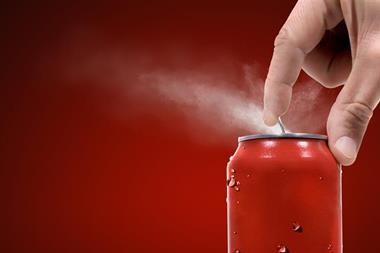All stores will soon have to display their food hygiene ratings for all shoppers to see, so it’s crucial retailers run a five-star operation
England and Scotland look set to force retailers to display their food hygiene rating on their premises in the near future. So if your standards aren’t up to scratch, shoppers will soon know about it.
Following the lead of Wales and Northern Ireland, the Food Standards Agency says it is “committed” to introducing the mandatory display of ratings to food outlets in England - and a similar move is also expected in Scotland. With most c-store retailers running some sort of food-to-go provision, there’s no better time to ensure your store gets full marks in food safety.
The local authority-run ‘Scores on the Doors’ rating system, already easily accessible online (www.scoresonthedoors.org.uk), can have a very real influence on business success. In fact, insurance firm NFU Mutual’s Food Hygiene Ratings Report (February 2017) found that almost half of people (44%) would turn away from a food outlet that had a food hygiene rating of three (generally satisfactory) or less on display - even if it was their personal favourite.
Darren Seward, NFU Mutual insurance specialist for the hospitality industry, says that while more rules and red tape are the last things most business owners want, having to display their rating in store could be turned into a business advantage.
He points out that businesses are at the mercy of all kinds of ratings, including those posted on social media. “Hugely popular, these consumer-driven networks are unregulated - which makes it very difficult if not impossible to get unfair or inaccurate posts amended or removed.
“Local authority food hygiene ratings aim to be a more objective, official measure of the state of an establishment - including behind the scenes. They are - in theory at least - free from bias and, importantly, they can be challenged if a business owner thinks they have been rated unfairly.
“So it makes good sense for businesses to embrace food hygiene ratings, using them as proof of good management and high standards.”
Kay Patel, who owns five Bestway-associated stores and a café in the London area, has a five-star rating (the highest possible). He says his shoppers definitely take note of this rating and he imagines that word could spread fast if your rating is less than perfect.
“I know that people will click on the link to the website and can easily look up the rating and send a link to their friends,” he says.
He believes that achieving a five-star rating has led to fewer inspections. “We have a five-star rating and therefore the inspector has left us alone. They will send us a form to fill out every year to ensure we are continuing our good practice, but they will concentrate on repeat inspections at the places that have fewer than five stars.”
Chris Shelley, co-owner of a Budgens store in Horsham, West Sussex, says retailers must welcome Scores on the Doors inspectors as they offer so much advice and guidance.
“Since we’ve moved store we’ve had two visits. The first was in the first four weeks of opening so we were slightly flying by the seat of our pants. But they were very fair and took that into account and we achieved five stars.
“In the latest inspection we were much better prepared as we had all our systems in place, which all come from Budgens.
“The inspector checks a wide spectrum of stuff. They ensure you have the systems in place to ensure all the daily checks are done, like the temperature on the chillers, probing the hot food and temperature checking deliveries. They also look at general cleanliness and standards throughout the store and bakery, and check there’s nothing gone beyond its sell-by-date.
“They also provide helpful advice. Both times, although we’ve received five stars, they’ve still been able to give us advice for improving standards further.
“It’s important not to be afraid of inspectors as they are there to help and support you. It’s an important thing for any business to have that five-star score on the door. I know that I look at that sort of thing when I’m shopping and so we have that score displayed proudly. It shows a level of professionalism.”
Chris believes the toughest part of keeping high standards of food hygiene is ensuring staff are well trained and follow procedure. He explains that this is where the paperwork becomes a crucial method of supervision.
“It is the sort of thing where people will cut corners and forget, so it’s important to keep on top of the paperwork,” he explains.
Stephen Walters, area manager at TYS Retail, which comprises five stores in Peterborough, points out that allowing an employee who is passionate about food safety to lead the team can be hugely beneficial. He says one staff member has a granddaughter with a particularly serious food allergy, so she has led the way in ensuring food is labelled with clear allergy advice.
“She’s well versed in allergens and so we take quite a lot of lead from her. That’s no bad thing to have someone like her on board!”
Staff discipline is an important element of maintaining hygiene standards, according to Leanne Duncan, food safety manager for Scotmid. She is currently running a project across stores to improve staff culture to make the teams understand and mindful of the importance of food hygiene.
“The toughest aspect of maintaining food hygiene would have to be staff culture. You have to ensure staff have the right attitude towards food hygiene and understand how important it is in order for them to maintain standards.”
Kay says it has been helpful to implement the checks and reporting methods used at his café, at his stores. “We train our café staff more meticulously in this area and have three members of staff who have done the food hygiene training and they will float across the stores, bringing their expertise with them,” he adds.
“We have lists of cleaning checks which have to be done daily, weekly and monthly, and staff have to sign off when they do the checks.”
Scotmid’s Leanne likes to ensure each store has a food hygiene champion who is trained in that area and can take responsibility for maintaining standards. She, like Kay, also shares the more trained staff across the stores.
Leanne adds that staffing is one of the reasons for opting not to prepare any raw meat in store, other than bacon for breakfast butties.
“The problem with raw meat is you have to have dedicated staff for preparation,” she says. “We usually like to train our staff to do multiple tasks, but this wouldn’t be possible for an employee working with raw meat. They also have to be kept very separate to the cooked meat preparation. It’s easier in a large supermarket where you have space for a whole raw meat counter with its own designated staff.”
Mulkerns Eurospar has a separate butchery section for raw meat preparation. The store employs three full-time chefs to make ready meals, as well as five butchers to prepare the meat. Store manager Thomas Magennis explains that these two departments ensure there is no cross-contamination and there is also a separate raw meat prep area within the deli.
Most retailers aren’t looking to expand their food-to-go to quite the same level as the Mulkerns business. Some retailers simply need help with offering a basic food-to-go range. Kay and Chris both point out that suppliers such as Aryzta Food Solutions and Country Choice are a great place to start as they create the hygiene training and procedures for them.
“They provide all the training and so you can’t really go wrong,” says Kay.
Hannah Morter, marketing executive for Country Choice, explains that as well as offering training, Country Choice’s website contains a number of training modules designed to test the knowledge of staff working in food to go.
While good food hygiene needs commitment, it’s definitely an area that can define your success. Make sure your staff are well trained and create a pro-active staff culture, and your scores will bring lots of shoppers through the doors.
Legislation to manage acrylamide
No matter how small your food-to-go offering, Scotmid’s food safety manager Leanne Duncan points out the importance of retailers taking it upon themselves to remain aware of new insights and legislation. For example, new EU legislation that came into force on 12 April requires businesses to manage acrylamide through their food management system.
Acrylamide forms naturally during high temperature cooking and processing, such as frying, roasting and baking, particularly in potato-based and cereal-based products. In our bodies, acrylamide is converted into another compound, glycidamide, which can bind to DNA and cause mutations.
It is not possible to eliminate acrylamide from foods, but action can be taken to ensure levels are as low as reasonably achievable.
The legislation describes practical measures to mitigate acrylamide formation in a range of foods.
Food business operators will be expected to:
Be aware of acrylamide as a food safety hazard and have a general understanding of how acrylamide is formed in the food they produce
Take the necessary steps to mitigate acrylamide formation in the food they produce, adopting the relevant measures as part of their food safety management procedures
Undertake representative sampling and analysis where appropriate, to monitor the levels of acrylamide in their products as part of their assessment of the mitigation measures
Keep appropriate records of the mitigation measures undertaken, together with sampling plans and results of any testing
Ensure measures are proportionate to the nature and size of the business
The new legislation applies to all food business operators that produce or place on the market foods including potato-based products, bread, breakfast cereals (excluding porridge), and coffee.
Top tips
How to achieve a five-star rating
The Food Standards Agency (FSA) provides detailed advice on all aspects of food hygiene and safety on its website.
Storage:
Ideally, store raw and ready-to-eat food in separate fridges, freezers and display units. If they are in the same unit, store raw meat, poultry, fish and eggs below ready-to-eat food.
Unwashed fruit and veg should be kept separate from ready-to-eat food and above raw meat. Cover cooked foods and other raw and ready-to-eat food.
Keep foods that are defrosting in the fridge in a covered container, below ready-to-eat food, or in a separate area of the kitchen away from other foods.
Preparation:
Prepare raw meat/poultry and other foods in different areas. If this is not possible, separate by preparing them at different times and clean and then disinfect thoroughly between tasks. Never use the same chopping board or knives for preparing raw meat/poultry and for ready-to-eat food (unless they have been thoroughly cleaned and disinfected in between).
Chillers:
In England, Wales and Northern Ireland it is a legal requirement that fridges and chilled display equipment are set at 5˚C or below. This is to ensure chilled food is kept at 8˚C or below. It is also recommended in Scotland. Check the temperature of your chilling equipment at least once a day.
To avoid keeping ready-to-eat food out on display for long periods, try using a ‘dummy’ portion which won’t be eaten.




























No comments yet